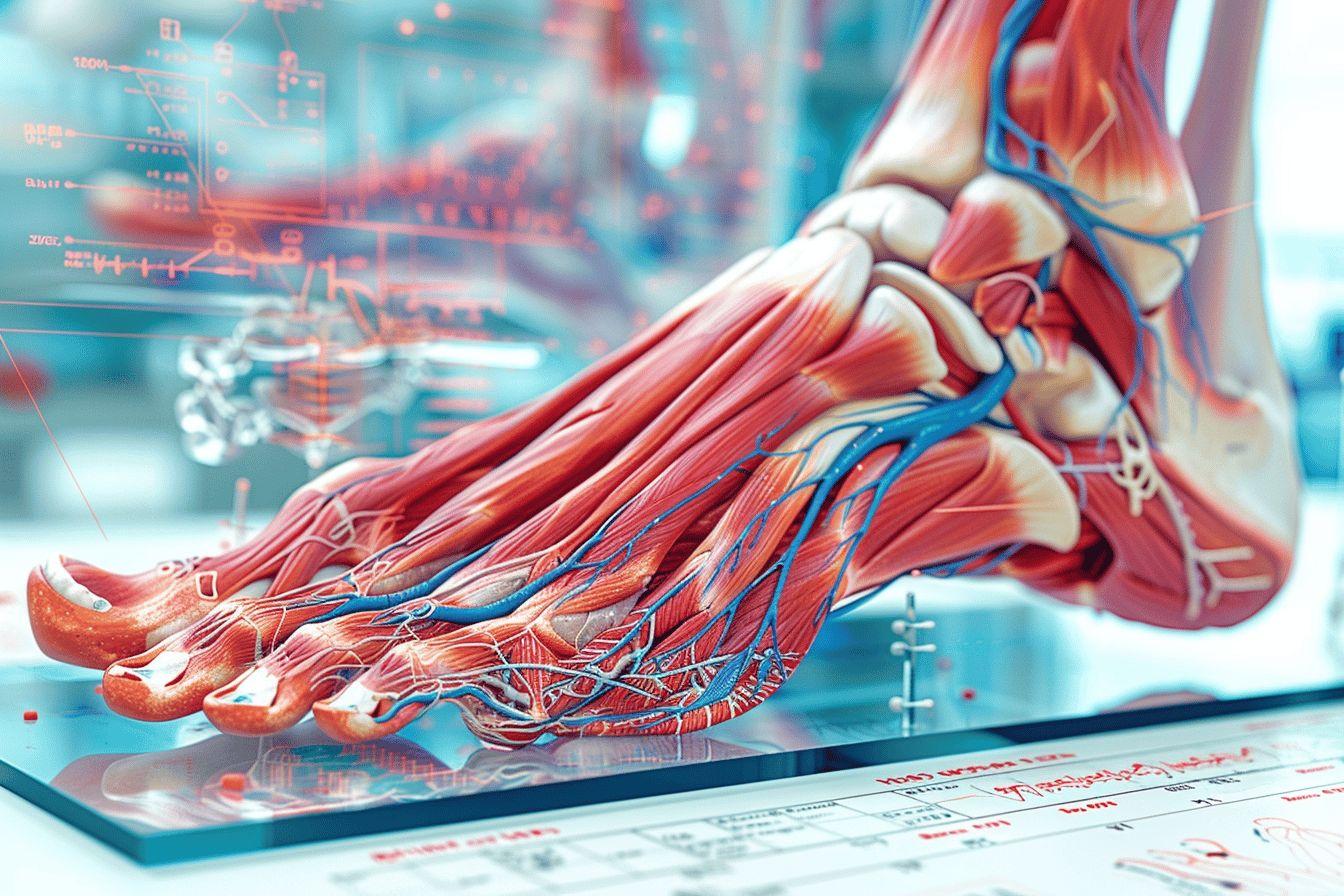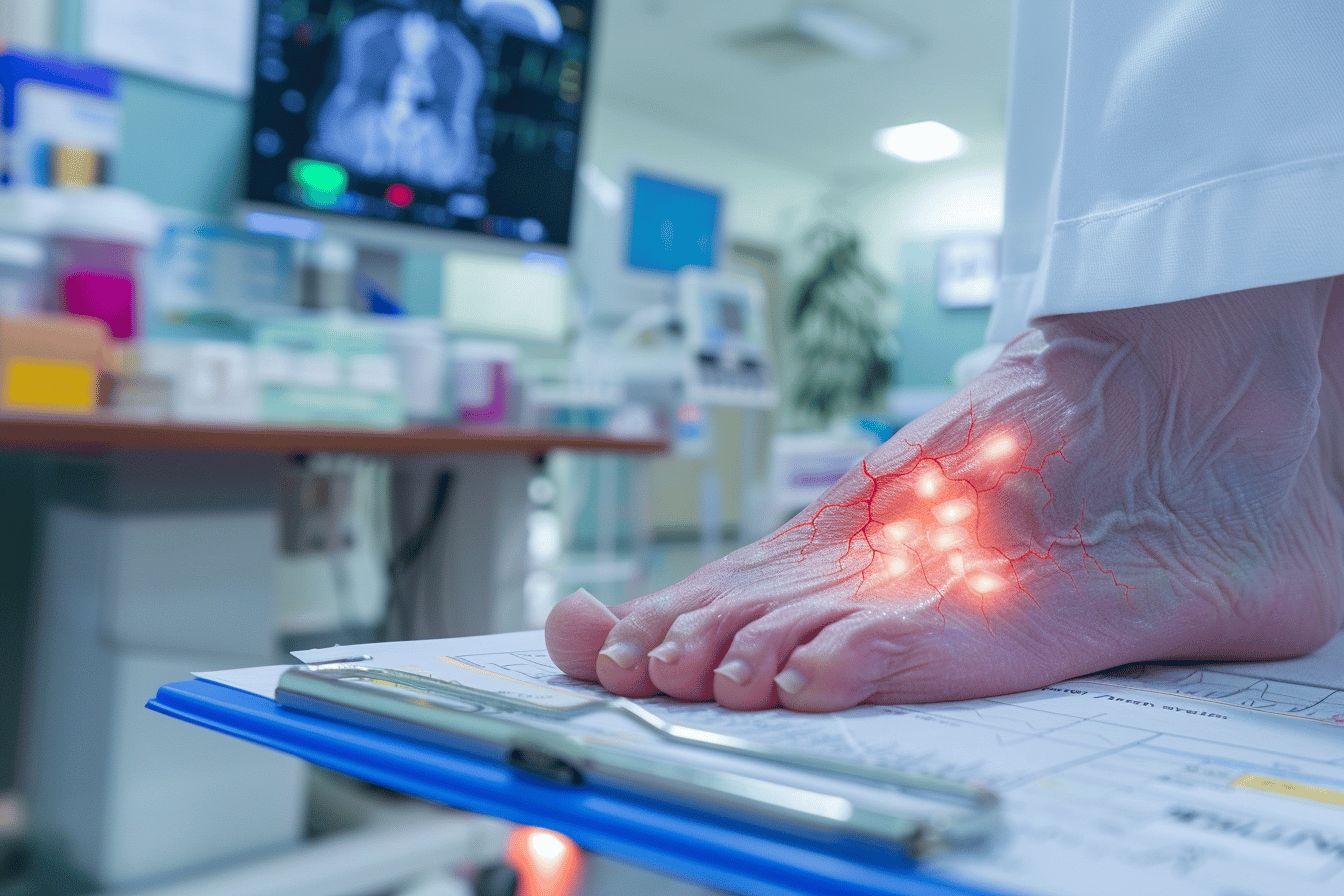Article at a glance
The anatomy of the human foot reveals a complex structure with essential functions for our daily mobility.
- Impressive structure: 26 bones, 33 joints, over 100 ligaments, and 20 muscles forming three distinct regions.
- The hindfoot (calcaneus, talus) supports the body's weight and absorbs shock.
- The midfoot contains the arch, which serves as a natural shock absorber while walking.
- The forefoot (metatarsals, phalanges) provides propulsion and balance in the face of considerable pressure.
Our foot, this marvel of natural engineering, carries us daily without us really paying it any attention. Yet, this complex structure composed of bones, muscles, ligaments, and nerves deserves our attention. Understanding the different parts of the foot and how they function helps us better care for this essential foundation for our mobility.
General Anatomy of the Foot: Structure and Components
The human foot is an anatomical masterpiece made up of 26 bones, 33 joints, over 100 ligaments, and 20 muscles. This elaborate structure is divided into three distinct regions, each with its own specificities and functions.
The hindfoot mainly consists of the calcaneus (heel) and the talus, which together form a solid base. These two massive bones support the entire body weight and absorb shock when walking or running. The calcaneus, the largest bone in the foot, serves as an anchor for the Achilles tendon, a crucial element for propulsion.
The midfoot contains five tarsal bones that form the arch of the foot: the navicular, the cuboid, and the three cuneiforms. This area acts as a natural shock absorber and distributes forces during walking. The arch of the foot is supported by the plantar fascia, an essential fibrous membrane that extends from the heel to the toes.
The forefoot is made up of the metatarsals and the phalanges. The five metatarsals form the front "skeleton" of the foot, while the phalanges make up the toes (three for each toe except the big toe, which has only two). This area bears considerable pressure when walking, particularly on the metatarsal heads.
| Foot Region | Major Bones | Primary Function |
|---|---|---|
| Rearfoot | Calcaneus, Talus | Support and Shock Absorption |
| Midfoot | Navicular, Cuboid, Cuneiform | Cushioning and Force Distribution |
| Forefoot | Metatarsals, Phalanges | Propulsion and Balance |
The bone structure of the foot varies from person to person, creating distinct morphologies such as the Egyptian foot, characterized by a big toe that is longer than the others, or the Greek foot, where the second toe protrudes.

Plantar and Dorsal Zones: Specific Functions
The sole of the foot, the lower part in contact with the ground, has a unique structure adapted to Locomotion. Its thick, resilient skin protects deep tissues while providing remarkable tactile sensitivity thanks to numerous sensory receptors. This region is divided into several functional zones:
- The heel: initial impact zone when walking
- The arch: cushioning and support structure
- The metatarsal pad: propulsion and balance zone
- The toes: stabilization and adaptation elements to the terrain
The dorsal surface of the foot, which is less mechanically stressed, has thinner and more flexible skin. It houses the extensor tendons of the toes and a visible vascular network, notably the pedal artery, whose pulsation is palpable. This area also contains important anatomical landmarks such as the extensor tendons and the pedal muscle.
Between these two surfaces lies a complex network of ligaments that maintain joint cohesion. The most significant are the deltoid ligament on the inside of the ankle and the lateral collateral ligaments. These fibrous structures limit excessive movements that could compromise the integrity of the foot.
The innervation of the foot comes mainly from the sciatic nerve, which divides into the medial and lateral plantar nerves. These transmit sensory information and control the intrinsic muscles of the foot. This rich network of nerves explains the intensity of foot pain and its overall impact on quality of life.
Biomechanics of the Foot: Functional Roles of the Different Parts
The human foot performs three major functions: support, cushioning, and propulsion. During walking, these functions are linked in a perfectly coordinated cycle that involves a series of complex movements.
In the heel strike phase, the rearfoot makes contact with the ground. The calcaneus absorbs the initial impact while the talus distributes the forces forward. At this point, the foot is slightly supinated (rotated outward) to stabilize the footing.
The mid-stance phase involves the midfoot. The arch flattens slightly to absorb shock and adapt to the terrain. The foot then enters moderate pronation, an essential movement for adapting to ground irregularities and absorbing impacts.
The propulsion phase mobilizes the forefoot. The metatarsals and toes create a lever arm that propels the body forward. It is during this stage that the big toe plays a crucial role in stabilizing the final push-off.
- Heel strike: initial absorption and stabilization
- Stance phase: adaptation and distribution of forces
- Propulsion phase: push-off and release of the foot
- Swing phase: preparation for the next push-off
The arches of the foot - medial and lateral longitudinal, and transverse - contribute to this sophisticated biomechanics. They form a natural suspension system that flattens under load and then springs back, creating a spring effect that conserves energy during walking.
Disorders such as flat feet (fallen arches) or high arches (excessively accentuated arches) can alter this mechanics and cause pain in the feet, knees, and even back. A good understanding of these mechanisms helps prevent many postural and joint disorders.





Leave a comment
This site is protected by hCaptcha and the hCaptcha Privacy Policy and Terms of Service apply.